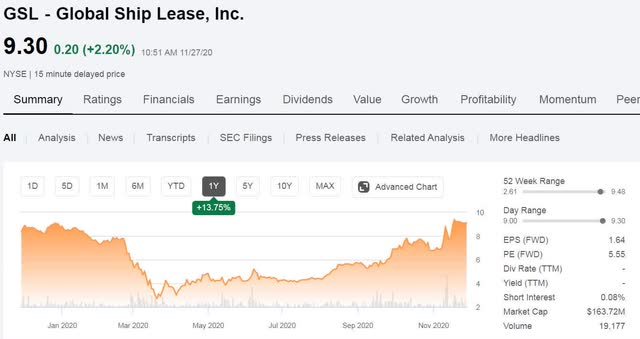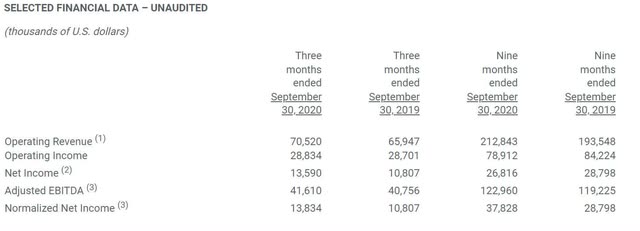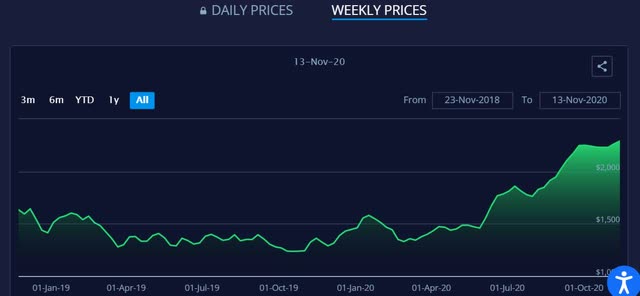Base economics
When we’re asked to think about basic economics we all do tend to recall that diagram at the front of the first book – those supply and demand curves meet and determine the price. Sadly, we can often forget it when thinking about actual extant markets out there in the real world.
I have, for example, seen reasonably serious people (OK, Zero Hedge, for what level of seriousness you think that means) insisting that a fall in prices must mean a drop in demand. The idea of checking supply just didn’t occur.
Thus we can get one step ahead of the game by recalling that Econ 101 – both supply and demand matter.
Global Ship Lease Inc (NYSE:GSL)
This is what we’ve got to consider when we think about Global Ship Lease. Yes, the pandemic, clearly global volumes of trade have fallen. That is, demand has fallen and there’s no doubt that it has. Why, then, is a shipping company doing well and why would I recommend it for the future? Because supply also matters.
 (Global Ship Lease stock price from Seeking Alpha)
(Global Ship Lease stock price from Seeking Alpha)
OK, so we can surmise a thing or two. Yes, global shipping volumes fall as a result of the virus. We also have had excellent news about vaccines and a rally on the back of that news. That rally itself, plus the news that trade will presumably increase, so will demand for shipping, that makes sense, right?
That doesn’t explain this though:
 (Global Ship Lease Q3 results from Global Ship Lease)
(Global Ship Lease Q3 results from Global Ship Lease)
Results – revenues and profits both – are up over the period of the pandemic drop in the economy and trade. So, something else is going on as well. We have indeed had a change in demand but the change in supply might well have been greater than that.
Shipping prices
As we saw when we looked at Maersk (OTCPK:AMKBY) this is indeed what has happened.
This is not the usual Baltic Dry index that we might know of. This is a new one, new this year, about container shipping rates, not the dry bulk of the better known one. This is important for Maersk as it is largely a container shipper. This is important for Global Ship Lease because it owns and leases out container ships.
OK, so it leases out, it’s not running a line where it has direct exposure to container rates. But the way markets work – as we all know – is that if the rental or service due to an asset rises then so does the price and lease rate of that asset. That’s what’s driving up revenues and profits – freight rates are rising.
The shipping cycle
Of course this is not entirely, wholly and only true, but largely enough shipping works in cycles. As I explained here some years back:
Analysts estimate the industry suffers from up to 30% overcapacity on some of the busiest ocean trade routes. Container ships move more than 95% of the world’s manufactured goods. New ship deliveries will boost capacity by 1.7 million containers, or 8.2%, while demand should top out at 2% this year, the lowest since 2009, estimates Jonathan Roach, a container analyst at London-based Braemar ACM Shipbroking.
People build ships now for what they think shipping will be like in 3 years’ time – around the delivery cycle for a new hull. So, back those 5 years ago hulls that had been ordered years before were coming onto the market but demand growth had slowed. Freight prices plummeted therefore.
Well, what comes next? Yep, you got it, where there’s a surplus of supply leading to low prices the least efficient supply withdraws from the market. Hulls are sent off to those beaches in Bangladesh where they’re taken apart with hacksaws. But as often happens, just as the supply increase can be excessive so can the withdrawal.
So, we find actual freight rates to be rather boom and bust. Very much greater than changes in actual demand because we have that procyclical change in supply as well.
So, what’s happening now?
We’ve one of those cyclical – supply driven – changes in freight rates going on. They’re going up. We’ve also had, this year, the pandemic drop in trade volumes. That fall in demand that we all expect to lift moving into next year, post-vaccine. We should probably be thinking that this will accelerate those freight rate rises.
This is, obviously, good for a company that leases out freighters.
The company thinks so too
Global Ship had a bond issue out there. At a pretty high interest rate too, over 9%. They called some in earlier in the year and they’ve just done the same again:
Global Ship Lease, Inc. (NYSE: GSL) (the “Company”) today announced that it has sent notice of mandatory partial redemption of its 9.875% First Priority Secured Notes due 2022 (the “Notes”) to holders of the Notes. The Company is mandatorily redeeming (the “Mandatory Partial Redemption”) of $28,000,000 aggregate principal amount of the Notes (the “Redeemed Notes”) at a redemption price equal to 102.00% of the principal amount thereof (the “Redemption Price”) plus accrued and unpaid interest to, but not including, the redemption date of December 7, 2020 (the “Redemption Date”).
They’re reducing the cost of their capital structure nicely as we move into an age of higher prices for the company’s extant assets. This is bullish for the stock.
My view
Of course, not all of us want to try riding something like the shipping cycle. It’s difficult to predict when it will end. Our signal as to when it will is to keep an eye on that FBX index of container freight rates. As that peaks then this leg of the cycle is over.
For the moment though I can see Global Ship Lease moving higher as it floats on the combination of a tight supply of hulls plus the revival in global trade volumes.
The investor view
This is speculation, this is not investment for widows and orphans. But if trying to ride the shipping cycle interests then Global Ship is a good place to do it. The cycle is on the up and looks like it will be for a few years yet.
Disclosure: I/we have no positions in any stocks mentioned, and no plans to initiate any positions within the next 72 hours. I wrote this article myself, and it expresses my own opinions. I am not receiving compensation for it (other than from Seeking Alpha). I have no business relationship with any company whose stock is mentioned in this article.


